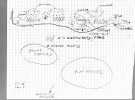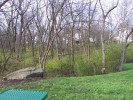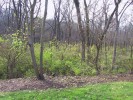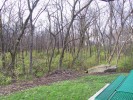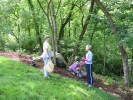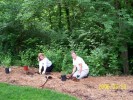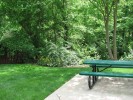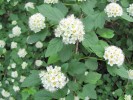By Betty Struckhoff
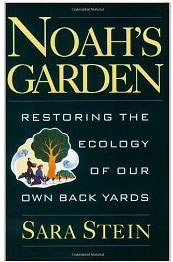
Sarah Stein’s wonderful book, Noah’s Garden, is a must-read for anyone interested in native landscaping. One of her suggestions for suburban yards is to create hedgerows of native plants near the back property lines. Once neighbors pick up the idea, a connected series of these yards can form the kind of wildlife corridor that helps native fauna thrive and reproduce.
Alas, in my little corner of suburbia the neighbors don’t seem to be catching on — yet. Their lives are not focused on the outdoors; they are happy to have a landscape service mow and weed whack once a week so they don’t have to think about it.
But there’s other land nearby that is taking on a different and more positive look. Shortly after our garden club created a butterfly garden near the subdivision’s playground, we noticed that the woodland border of the area had become choked with ugly, non-native, invasive bush honeysuckle. Longtime residents remembered when it was open woodland with spring wildflowers.
The garden club was up to the task! We had our subdivision’s landscape service remove the bush honeysuckle one fall and the following spring planted shrub seedlings purchased from the Missouri Conservation Department. Today the woodland border is a delightful multi-culture – Spicebush, Ninebark, Gooseberry, Viburnum, Deciduous Holly, Elderberry, Redbud, Dogwood, Paw Paws and Golden Currant provide flowers and berries through the seasons. In the spring, Trillium has reappeared and Trout Lilies showed up to decorate a steep hillside. We have added Bluebells, Wild Sweet William, Celandine Poppies and May Apples from our yards.
Thanks to others (mostly Wild Ones members) who have shared extra seedlings, we have a Burr Oak, a Chinquapin Oak and two Bald Cypresses getting established behind the shrubs. Huge Pokeweed has moved in and its deep purple stems and berries form an interesting backdrop to the foliage of the shrubs.
Now parents and children enjoying the playground venture over to check out the interesting plants. I mentioned to one young dad that we conserved subdivision funds by buying very young seedlings that will take a few years to get established. His reaction: “I’m not going anywhere and it will be fun to watch this grow up with my children.”
The cost for all of this – the cost of honeysuckle removal and about $50 for the seedlings. The garden club continues to yank out unwanted tree and shrub volunteers, a very minimal amount of maintenance.
Thankfully, ours is not the only neighborhood with native ideas. Nearby, another subdivision has a large patch of ground that is the easement for an electrical line. Like our area, it follows a hillside but in this case is wide open to the sun – no trees allowed. As is typical, it was planted in non-native grasses and mowed a few times per year.
Luckily, this subdivision has another native plant enthusiast. She obtained permission from the electric company and the subdivision to create a native prairie that winds down the hillside. Parts of it have wetland plants behind terraces that slow down the water flow. An asphalt path winds through the area with park benches for folks to stop and enjoy. On a recent evening, I scared up a big flock of Goldfinch enjoying the Gray Headed Coneflower seed heads.
The best part of this story – connecting the woodland border and the prairie is 23 acres of wooded conservation land. It was donated by landowners who owned the properties long before the subdivisions were built over 30 years ago. Our city parks department has created mulched paths through the conservation area.
We’ve turned common ground into an uncommonly inviting area for wildlife, a corridor that extends from woodland border, through woodland to prairie. As neighbors enjoy what native plants have to offer, I’m hoping they will welcome more into their own backyards.
Editor’s note: Here is a photo gallery of the transformation. Click any image for a larger version.
- Planting diagram for shade garden
- Woodland edge in 2004 before clearing bush honeysuckle
- Woodland edge after clearing bush honeysuckle
- Woodland edge after clearing bush honeysuckle
- Planting wildflowers, May 2005
- Planting Golden Currants (Ribes aureum), Spring 2006
- Ninebark (Physocarpus opulifolius) and Squaw-weed (Senecio obovatus)
- Ninebark (Physocarpus opulifolius) flowers

